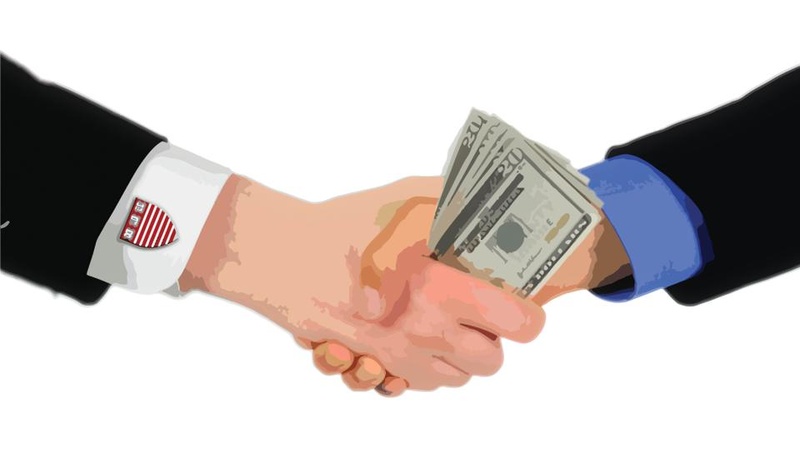UPDATED: May 29, 2013, at 5:01 p.m.
“There’s a Harvard man on the wrong side of every question,” runs the famous quotation by former University President A. Lawrence Lowell, Class of 1877.
In the fall of 1987, Dean of the Kennedy School Graham T. Allison ’62 found himself on the wrong side of a scandal resulting in increased oversight of fundraising in Harvard’s schools.
Earlier in the year, the Kennedy School of Government had announced its intention to implement a number of public service initiatives, including a loan forgiveness program for its students, 15 to 20 of whom were eligible. At the time, however, the Kennedy School had not secured any funding to support it.
That November, after The Harvard Crimson reported that Allison had solicited a $500,000 donation for this purpose in exchange for offering the donors official positions within the University, the resulting media frenzy attracted harsh criticism that some Kennedy School affiliates thought was unfair.
But even as the fundraising scandal fades into the past, important questions about the ethics of fundraising within Harvard still linger.
THE COUPLE FROM TEXAS
Harvard Divinity School graduate Charles C. Dickinson III and Joanne W. Eaton Dickinson, Texas natives, were described in Kennedy School memos as a “curious and restless couple.”
They had held positions at schools nearby and abroad; Charles Dickinson had served as a curatorial associate of manuscript collections at the Andover-Harvard Theological Library and was a lecturer of psychiatry at Harvard Medical School in 1987, where he enjoyed full access to the school’s library facilities. The couple, however, was better known for their inheritance of a family oil business and their many donations to educational institutions.
According to Bailey F. Mason ’51, who was an administrator in the Dean’s office at the Kennedy School at the time of the scandal, the Dickinsons were “generous donors” who had asked a lawyer to draft an official agreement ensuring that after a first-time dona- tion to the Kennedy School, they would hold access to further research facilities. The Dickinsons hoped to gain access to Widener Library—a right not unlike the privilege Dickinson already held at the Medical School—in addition to membership in the Faculty Club, Mason said.
At the time, only two types of identification cards allowed access to Widener Library: those for students, and those for professors and University officials. The documents noted that the Dickinsons would be issued University official cards to this end.
In early November of 1987, the memo outlining this exchange was leaked to The Crimson, thrusting the Kennedy School into the national spotlight.
A STORY THAT WASN’T
Soon after the original agreement papers were finalized in the Dean’s office, The Crimson published a story alleging that Allison intended to “bestow University Officer status on an oil-rich Texas couple in return for a $500,000 gift,” in the words of a Crimson editorial written soon after the scandal broke.
Before the University had the chance to respond to the allegations, several news sources picked up The Crimson’s story, echoing sentiments that Allison’s actions were improper. “The Kennedy School’s explosive growth has entailed some insensitivity to ethical constraints,” read a New York Times article. A Boston Globe editorial was even more severe: “The gang running Harvard would put a pack of Chicago aldermen to shame. When it comes to extortion, these people are definitely major leaguers,” it contended.
Read more in News
Student Complaint Sparks Debate Over Campus SexismRecommended Articles
-
 MEN'S VOLLEYBALL: Harvard Enjoys Best Season in Almost 20 Years
MEN'S VOLLEYBALL: Harvard Enjoys Best Season in Almost 20 Years -
Men's Volleyball Suffers Weekend SetbackIt was a tough weekend for the No. 14 Harvard’s men’s volleyball team, who saw their six-game winning streak stopped on Friday. The Crimson only won one set of seven in its two-game, two-day stretch against George Mason and Princeton.
-
Men's Volleyball Splits Weekend Play, Earns Playoff BidHarvard men’s volleyball (14-8, 7-4 EIVA) clinched a spot in the EIVA Playoffs this weekend, splitting its two home games against Princeton (10-8, 8-4) and George Mason (14-3, 10-3).
-
Men's Volleyball Secures Spot in Playoffs With Weekend SplitThe Harvard men’s volleyball team (14-8, 7-4 EIVA) clinched a berth in the conference playoffs this weekend after splitting its two home fixtures against Princeton (11-8, 9-4) and George Mason (14-11, 10-3).
-
Men's Volleyball Seeks Revenge in Tournament OpenerAfter finishing the season strong, the Harvard men’s volleyball team will challenge George Mason on Thursday night in the first round of the EIVA conference tournament.
-
 By the Numbers: Men's Volleyball EIVA Preview
By the Numbers: Men's Volleyball EIVA Preview














